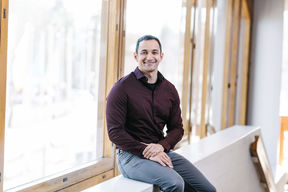Michael Hummel knows breakthrough research is hardly ever a one-man show

Who are you and what do you do?
I have worked as a postdoc researcher in Prof. Herbert Sixta’s Biorefineries group at the Department of Forest Products Technology since 2009. Prof. Sixta had the vision to develop a new fiber spinning process based on so called ionic liquids. The goal was to turn wood pulp into fibers for textile and technical applications and, supported by highly motivated and hardworking postgraduate students, we planned and installed the process equipment and spent countless hours in the laboratory. It took us 4 years before we had the breakthrough on a very nice spring day in 2013. Since then we have expanded the team and the scope of our research considerably. Alternative raw material was investigated to produce fibers and filaments of high quality. We realized that we can also use waste material as cellulose source. Meanwhile, waste paper and cardboard, and waste cotton textiles can be turned into high-performance fibers using our process that became known as Ioncell-F.
How did you become a researcher?
Admittedly, I entered the field of biorefinery by accident and totally unplanned. During my dissertation work at the University of Innsbruck I was involved in projects related to ionic liquids. At the beginning, using those liquids as solvent for cellulose was only a small part of my research tasks. However, as so often for PhD students, the funding for my original project ran out and the last 6 months of my doctoral studies were financed via a small project with Lenzing AG, where Professor Sixta was the head of the R&D unit before he moved here. I got to know him and the exciting world of cellulose and after moving to Finland to join his group there I got totally intrigued by wood as a raw material. I believe research at Aalto University is characterized by a unique balance of fundamental studies and application-targeted research which helped me to become the researcher that I am today.
Your project has received ca. 1.5 M€ funding through an ERC starting grant. What does it require to succeed in competing for funding?
I think breakthrough research is hardly ever a one-man show and it requires a multi-disciplinary group of highly qualified and highly motivated partners for cutting-edge research. Pursuing the production of wood-based carbon fibers it was evident that we would need an expert in carbon fiber research and production. After searching for suitable partners across Europe for 2 years, I met the perfect group on a conference in Sydney. Their expertise and enthusiasm, combined by an outstandingly encouraging department at Aalto University motivated me to compete for the highest funding within my personal reach. Highly supported on both the School and Department level, I started to prepare the application. The preparations included a research stay at Deakin University to perform experiments and gain initial knowledge. This joint efforts have led to a strong proposal. The last hurdle was the interview and packing a 5-year project into 5 minutes of presentation. But also there I got great support and feedback from my colleagues. And then I believe in the end you also need this tiny bit of luck. But hey: Nothing ventured, nothing gained!
How does your research shape the society? How does it help to resolve problems in society?
In general, we at the Department of Forest Products Technology are working on problems in particular related to the finite amount of resources that our planet offers. This comprises the replacement of currently oil-based products with material from renewable resources. Wood and its constituents offer numerous possibilities. My research ties in with that strategy. Lightweight carbon fiber composites with their outstanding mechanical properties have the potential to replace metal in many applications. In particular in the transportation sector this would allow to save considerable amounts of fuel and energy. Currently PAN-based carbon fibers are an expensive commodity. The high price prevents widespread implementation in the automotive sector. My goal is to produce carbon fibers from wood-based polymers to replace PAN with a renewable source and reduce the price of carbon fibers. The resulting carbon fibers are probably weaker than those derived from PAN but would still fulfill the requirements for application in car parts and sports equipment. The vision is that this would allow to implement carbon fibers in cars on such a high level as it is already in the aeronautics sector.
What gives you the energy and inspiration in your work? Could you give some examples of this?
It is working with motivated and passionate people. All those months and years of research with little or no success are so much more bearable when you work with people that share your passion. It can be the knowledgeable professors that can teach you new things even after numerous years, an outstanding expert that you meet at a conference, or a student that looks at a problem with absolutely unbiased eyes. All together as a team you can enjoy those few but so precious moments when you succeed in your research. And sometimes even a seemingly small progress can lead to something of true value. It is the excitement that every day you could discover something new that drives me.
- Published:
- Updated:
Read more news

Get to know us: Associate Professor Maria Sammalkorpi
Sammalkorpi received her doctorate from Helsinki University of Technology 2004. After her defence, she has worked as a researcher at the Universities of Princeton, Yale and Aalto.
Aalto computer scientists in ICML 2024
Computer scientists in ICML 2024
Getting bacteria into line
Physicists use magnetic fields to manipulate bacterial behaviour